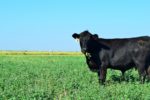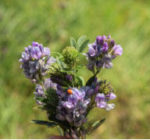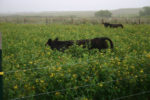The educational materials listed on this page are about Integrated Crop and Livestock Systems.
Crops and livestock were traditionally integrated in most farming systems. Integrated crop and livestock farming can improve nutrient cycling. Integrated management, or integrated farming, can also reduce off-farm impacts and improve water management. Integrated crop livestock systems also interrupt pest cycles on farms. Reduced economic risk through diversification on integrated crop-livestock systems is an added benefit to the integrated production system. Resources on integrated farm systems can be recycled more efficiently. Integrated crop and livestock operations may also benefit from increased efficiency in yields. The advantages to integrated agriculture are numerous for both the land and the farmer. Key practices include crop rotation, nutrient management, nutrient cycling, forage management, multispecies grazing, pasture fertility, physical control, stocking rate.
SARE’s Crop Rotation on Organic Farms: A Planning Manual can help farmers identify strategies that will help improve soil quality and health, and manage pests, diseases and weeds. A Whole-Farm Approach to Managing Pests is a helpful bulletin that serves as a guide in designing a farm-wide approach to controlling pests. Visiting The Small Ruminant Toolbox will aid producers looking to diversify their operation by incorporating small livestock enterprises, which provide added benefits to crop rotation and pest and weed control.
Showing 1-3 of 3 results

The Performance of Cover Crops in Minimally Tilled Forage-based Grazing Systems
In a Southern SARE-funded Graduate Student Grant (GS15-152), “Evaluation of Winter Annual Cover Crops Under Multiple Residue Management: Impacts on land management, soil water depletion, and cash crop productivity,” Texas Tech University researchers investigated five cover crops species as potential complements to a warm-season beef-stocker grazing system. The impact of the project was two-fold: Stabilize the soil surface from excessive wind erosion and desiccation; and strengthen rural communities by ensuring the persistence of profitable agriculture in the region.

Integrating Legumes with Grass to Improve Forage-Livestock Systems
In a Southern SARE-funded Research and Education Grant (LS14-261), "Long-term Agroecosystems Research and Adoption in the Texas Southern High Plains -- Phase III," Texas Tech University researchers conducted a steer grazing trial comparing a grass only system to a grass-legume system for animal productivity and water use efficiency.

Grazing Cover Crops in Cropland
For some producers with extensive experience using cover crops, grazing can be a ‘next step’ in obtaining additional economic value while achieving environmental stewardship.